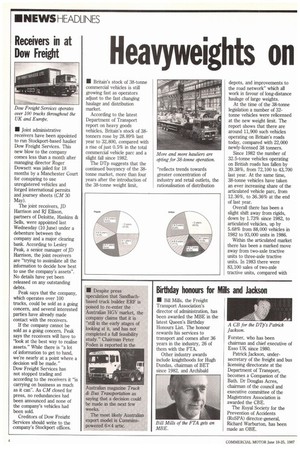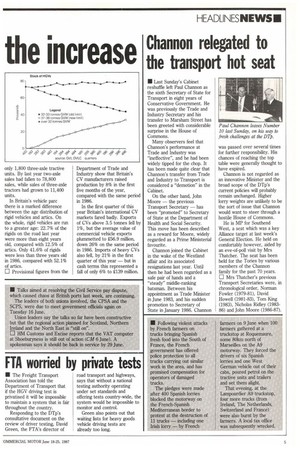eavyweights on the increase
Page 6

Page 7

If you've noticed an error in this article please click here to report it so we can fix it.
• Britain's stock of 38-tonne commercial vehicles is still growing fast as operators adjust to the fast changing haulage and distribution market.
According to the latest Department of Transport report on heavy goods vehicles, Britain's stock of 38tonners rose by 28.89% last year to 32,800, compared with a rise of just 0.5% in the total commercial vehicle parc and a slight fall since 1982.
The DTp suggests that the continued buoyancy of the 38tonne market, more than four years after the introduction of the 38-tonne weight limit, "reflects trends towards greater concentration of industry and retail outlets, the rationalisation of distribution depots, and improvements to the road network" which all work in favour of long-distance haulage of large weights.
At the time of the 38-tonne legislation a number of 32tonne vehicles were relicensed at the new weight limit. The report shows that there are around 11,900 such vehicles operating on Britain's roads today, compared with 22,000 newly-licensed 38 tonners.
Since 1982 the number of 32.5-tonne vehicles operating on British roads has fallen by 39.38%, from 72,100 to 43,700 last year. At the same time, 38-tonne vehicles have taken an ever increasing share of the articulated vehicle parc, from 12.36%, to 36.36% at the end of last year.
Overall there has been a slight shift away from rigids, down by 1.73% since 1982, to articulated vehicles, up by 5.68% from 88,000 vehicles in 1982 to 93,000 units in 1986.
Within the articulated market there has been a marked move away from two-axle tractive units to three-axle tractive units. In 1983 there were 83,100 sales of two-axle tractive units, compared with only 1,800 three-axle tractive units. By last year two-axle sales had fallen to 78,800 sales, while sales of three-axle tractors had grown to 11,400 units_ In Britain's vehicle parc there is a marked difference between the age distribution of rigid vehicles and artics. On the whole, rigid vehicles are run to a greater age: 22.7% of the rigids on the road last year were more than eight years old, compared with 12.5% of artics. Only 41.6% of rigids were less than three years old in 1986, compared with 52_1% of artics.
0 Provisional figures from the Department of Trade and Industry show that Britain's CV manufacturers raised production by 8% in the first five months of the year, compared with the same period in 1986.
In the first quarter of this year Britain's international CV markets fared badly. Exports of CVs above 3.5 tonnes fell by 1%, but the average value of commercial vehicle exports plurrunetted to £56.9 million, down 26% on the same period in 1986_ Imports of heavy CVs also fell, by 21% in the first quarter of this year — but in cash terms this represented a fall of only 6% to £139 million_




































































































